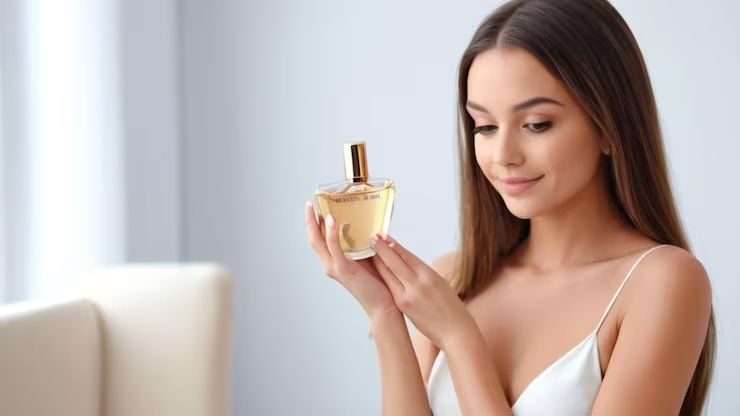Women’s perfumes have existed for centuries as a way to express identity, culture, and emotion. From ancient civilizations that used natural oils and resins to modern-day fragrances developed through advanced chemistry, perfume has been closely tied to beauty, tradition, and self-expression.
Importance
Perfumes play a significant role in daily life and society:

-
Personal expression: A chosen fragrance often reflects an individual’s personality or mood.
-
Cultural significance: Perfumes carry traditions and are used in ceremonies, rituals, and festivals.
-
Psychological impact: Scents can influence emotions, reduce stress, and enhance confidence.
-
Fashion and lifestyle: Perfumes are considered an essential accessory, complementing style and presence.
-
Economic value: The fragrance industry supports global trade, employment, and innovation in cosmetics.
Perfumes solve the desire for individuality, memory creation, and emotional connection, offering a balance of beauty and sensory experience
Recent Updates
Perfume trends and innovations have shifted notably in the past year:
-
Personalized fragrances: In 2023 and 2024, many brands began offering customizable perfumes, allowing individuals to select notes that reflect their preferences.
-
Sustainable ingredients: Growing awareness of environmental impact has encouraged the use of ethically sourced and plant-based raw materials.
-
Water-based perfumes: Recent launches have introduced alcohol-free perfumes that are lighter and considered skin-friendly.
-
Niche fragrance growth: Unique, artisanal blends are gaining popularity as people look beyond mass-market scents.
-
Digital sampling: In 2024, virtual try-on tools and scent discovery apps became more widely available, helping consumers explore perfumes online before committing to a choice.
These updates highlight how women’s perfumes are evolving with technology, sustainability, and personal preference at the forefront.
Laws or Policies
The perfume industry is regulated to ensure safety, transparency, and ethical sourcing:
-
Ingredient regulations: Many countries, including those in the European Union, regulate allergenic or potentially harmful fragrance ingredients through cosmetic directives.
-
Labeling requirements: Perfume packaging must disclose essential information such as ingredients, allergens, and expiration dates.
-
Environmental policies: Rules exist around sustainable sourcing of natural ingredients like sandalwood and musk to prevent overharvesting.
-
Animal testing bans: Regions like the EU and India have strict bans on testing perfumes on animals.
-
Import/export controls: Countries often have customs regulations for perfumes to ensure authenticity and safety.
These laws ensure that perfumes are safe for users, ethically produced, and environmentally responsible.
Tools and Resources
Several tools and resources can help individuals explore and learn about women’s perfumes:
-
Fragrance databases: Online platforms that catalog perfumes, their notes, and reviews.
-
Perfume finder apps: Tools that suggest fragrances based on scent families or mood preferences.
-
Allergen checkers: Websites that help identify potential sensitivities in perfume ingredients.
-
Sustainability directories: Resources listing eco-certified fragrance makers and sustainable perfume houses.
-
Educational guides: Online tutorials and blogs explaining fragrance notes, families, and layering techniques.
Example Table: Common Perfume Families
| Perfume Family | Characteristics | Popular Notes |
|---|---|---|
| Floral | Soft, romantic, feminine scents | Rose, jasmine, lily |
| Oriental | Warm, exotic, sensual | Vanilla, amber, musk |
| Woody | Earthy, elegant, grounding | Sandalwood, cedar, patchouli |
| Fresh | Light, clean, energizing | Citrus, green tea, oceanic |
This classification helps in understanding how perfumes are structured and how individuals can select fragrances aligned with their personality or lifestyle.
FAQs
What is the difference between eau de parfum and eau de toilette?
Eau de parfum has a higher concentration of fragrance oils and tends to last longer, while eau de toilette is lighter and usually fades more quickly.
How long does a perfume last once applied?
On average, perfumes last between 4–8 hours depending on concentration, skin type, and environmental conditions.
Can perfumes cause allergies?
Yes, some ingredients may trigger skin sensitivities. Always check the allergen information provided on labels.
What is perfume layering?
Layering involves using multiple products like body lotion and perfume with similar notes to enhance and prolong the scent.
Are natural perfumes safer than synthetic ones?
Not always. Both natural and synthetic ingredients can cause allergies; what matters most is regulatory compliance and personal sensitivity.
Conclusion
Women’s perfumes are more than fragrances—they are a blend of history, culture, science, and personal expression. Recent innovations such as sustainable ingredients, digital sampling, and personalized scents show how the industry continues to adapt to modern preferences.
With established regulations ensuring safety and quality, perfumes remain a trusted part of lifestyle and identity. By exploring perfume families, tools, and trends, individuals can better understand how scents connect with personality, memory, and emotion.
Perfume will likely continue evolving with sustainability and technology, but its core role as a form of beauty and self-expression remains timeless.